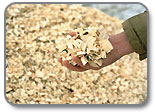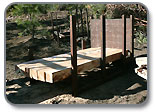Woody Biomass Energy
Oregon's abundant forests provide great potential to generate renewable energy from woody biomass. Wood-to-energy projects can support forest restoration and stewardship, expand economic opportunities, and encourage greater energy independence that benefits rural communities across the state.
What is biomass?

Woody biomass is defined as the trees and woody plants, including limbs, tops, needles, leaves, and other woody parts, grown in a forest, woodland, or rangeland environment, that are the by-products of forest management. Woody biomass utilization is the harvest, sale, offer, trade, or utilization of woody biomass to produce bioenergy and the full range of biobased products including lumber, composites, paper and pulp, furniture, housing components, round wood, ethanol and other liquids, chemicals, and energy feedstocks.
- Resilient forests
A century of fire suppression and other factors has left many BLM managed forests, especially in eastern Oregon and Washington, in need of thinning. Overstocked forests are at higher risk or insect and disease infestation and catastrophic wildfire. Woody biomass is a byproduct of forest treatments that are taking place now to increase forests resiliency. - Job for local economies
In addition, because overstocked forest stands tend to be in more rural parts of the state, the jobs and commerce created through thinning and slash reduction helps revitalize the economies in rural communities. Modern, innovative sawmills employ residents and provide thousands of dollars to the local economies. They also provide markets for the byproducts of active forest management needed to keep our public forest lands resilient and sustainable. - Using forests for energy
Humans have a long history of utilizing forests for sustenance—including food, fuel, shelter, clothing, fences and numerous other uses. As we continue to use wood products, it makes sense to also use the low-grade material and wood wastes that are generated to displace fossil fuels for heating. In fact, providing markets for these low-grade and waste materials is a key component of both sustainable harvesting and forest conservation, helping forested parcels maintain long-term value as a sustained resource. Sustainably produced biomass from forests is a local renewable energy source that keeps energy dollars circulating in the local economy by creating markets for low-grade wood, adding economic vitality and jobs to the forest-products industry, and improving the health of our forests.
Oregon Wood Energy Cluster Pilot Project
Oregon recently received the nation's first grant to support a Wood Energy Cluster Pilot Project. This effort will help develop small clusters of projects that compliment current forest restoration activities. The projects can provide heat and power to schools, hospitals, commercial buildings and industrial facilities.

In the coming months, the team will work with collaborative partners to identify and promote clusters of potential projects focused on forest restoration and biomass use in central, southern, and northeast Oregon. Projects that participate will be eligible to receive technical assistance and resources to assist with evaluation and early stage development.
Lessons learned during the process will also be collected and disseminated to interested parties to serve as a model for future wood-to-energy efforts in Oregon and in states across the nation.
- The Oregon Wood Energy Cluster Pilot Project is a cooperative effort between the USDA Forest Service, Oregon Department of Energy, Oregon Department of Forestry, Sustainable Northwest, and the BLM to explore and evaluate these opportunities for the benefit of rural Oregon communities.
- OR Wood Energy Cluster Pilot FAQs (PDF)
Juniper Biomass

Juniper treatments are a key component of rangeland and sage grouse habitat restoration. We can utilize the juniper biomass to make value-add wood products like posts and poles, furniture or wood pellets instead of burning it. The restoration work has tremendous opportunity to create jobs, provide new economic opportunities to the wood products industries throughout Oregon, including utilization of juniper biomass.
Memorandum of Understanding with the Confederated Tribes of Warm Springs

The BLM and U.S. Forest Service signed an agreement with the Confederated Tribes of the Warm Springs in January, 2006 that could create dozens of new jobs on the ecnomically depressed reservation. The agreement, which spans 20 years, creates a commitment to a long-term fuel supply for the Tribes' biomass project which has been several years in the planning stages. Specificially, the agreement calls for the BLM and the Forest Service to do forest thinning and management that would provide biomass fuel for a biomass plant on 8,000 acres annually near or adjacent to the Warm Springs Reservation. For the Tribes, the agreement represents a crucial piece of what is essentially a three-legged stool. The other two legs are an agreement with a utility to purchase the power they produce and money to finance construction of the biomass plant
